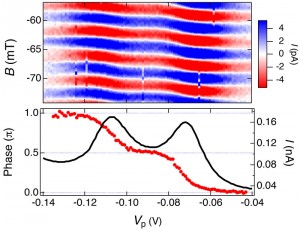First observation of phase shift of an electron wave function scattered off a Kondo state Proof of a prediction made 40 years ago

The Kondo effect first proposed theoretically by Jun Kondo in 1964 is one of the best known many-body spin related electronic correlations. It arises due to the interaction between a localized spin and many surrounding conducting electrons, resulting in cancellation (screening) of the localized spin. Electronic properties of the Kondo state are described by scattering of an electron incident on the Kondo state. An electron scattered off the Kondo state preserves its spin because the localized spin is screened, but it acquires a π/2 phase shift in the wave function, which can be viewed as a fingerprint of the spin screening. This π/2 phase shift, predicted about 40 years ago, is known as one of the hallmarks of the Kondo effect. Although numerous experimental attempts have been made to observe it all over the world, it has remained elusive due to technical difficulties.

© 2014 Seigo Tarucha.
Observation of the phase acquired by an electron wave function transmitting across a quantum dot in the Kondo regime. The upper panel shows the oscillating component of the current I through the two-path interferometer as a function of the perpendicular magnetic field B. Vp is the parameter that modulates the energy levels of the quantum dot. The lower panel shows the phase shift extracted from the upper panel (red points). The black curve in the panel is the current I through the quantum dot. The two current peaks correspond to the localized levels in the quantum dot, between which the Kondo state is formed. The phase shift is locked at 90 degrees in the Kondo regime.
A group at Department of Applied Physics at the University of Tokyo, consisting of Dr. Shintaro Takada, Dr. Michihisa Yamamoto (lecturer) and Prof. Dr. Seigo Tarucha, succeeded in observing the Kondo π/2 phase shift for the first time, embedding a quantum dot into a unique two-path interferometer and tuning it into the Kondo regime. The obtained result is clear and of historic importance in the field of electronic properties of solids.
The key ingredient of this work is use of a newly developed interferometer, which enables detection of the scattering phase with great precision. The group also proved the usefulness of such a two-path interferometer; it works as a new type of electronic device utilizing the phase as an information resource and can therefore be used in quantum information technology.
This result was obtained in collaboration with groups at RIKEN, Neel Institute, France, and Ludwig-Maximilians University and Bochum Ruhr University, Germany.
Paper
S. Takada, C. Bauerle, M. Yamamoto, K. Watanabe, S. Hermelin, T. Meunier, A. Alex, A. Weichselbaum, J. von Delft, A. Ludwig, A. D. Wieck, and S. Tarucha,
“Transmission phase in the Kondo regime revealed in a two-path interferometer”,
Physical Review Letters 113 (2014), 126601. Online Edition: 2014/9/15 (Japan time), doi: 10.1103/PhysRevLett.113.126601.
Article link (Publication、UTokyo Repository)
Links
Graduate School of Engineering
Department of Applied Physics, Graduate School of Engineering
Tarucha-Yamamoto Laboratory, Department of Applied Physics, Graduate School of Engineering






